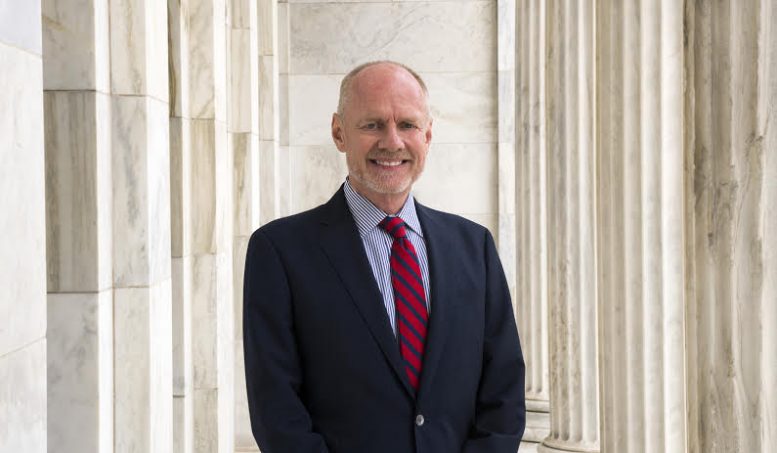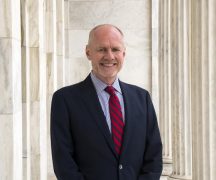By DAVID DUPONT
BG Independent News
After 40 years of museum work, John Stanley decided it was time to retire.
He could have gone anywhere, the 63-year-old said in an interview earlier this month. He decided to return to Toledo “because it’s home.”
This is where he was raised.
After leading major renovation and building projects at two of the world’s top museums, the Museum of Fine Arts in Boston and the Whitney Museum in New York, he felt he wanted to start a second chapter.
Brian Kennedy, then director of the Toledo Museum of Art, had other ideas. He called “cajoled” Stanley to return to the museum part-time as director of special projects to help develop the museum’s master plan.
Stanley said “yes” and returned to the institution where he got his start. Then on his first day on the job in March, Kennedy had more news for him. He was leaving to direct the Peabody Museum in Massachusetts.
Soon after Stanley was asked by the Board of Directors to become the Toledo Museum’s interim director. “I call myself the accidental director. In so many ways l never should have been in this business in the first place, never mind this particular role I have right now.”
He assumed the top job at the museum on July 1.
His career started there in a far less auspicious position — a part-time stock clerk, and he wasn’t even hired for that position when he first applied.
Growing up in Toledo with a businessman father and an artistic mother, he attended Saturday morning classes at the museum. He didn’t like the classes, but he enjoyed going up into the galleries afterward.
Stanley career path seemed pretty certain. His father was a manufacturing representative for a number of companies, including selling fishing tackle to “mom and pop shops” as well as selling shoes. Stanley was following in his footsteps. His father bought a couple businesses that they intended run together after Stanley graduated from the University of Toledo where he was studying business.
Then the elder Stanley died at 51. His son was 20, and too young to take on the businesses. So he and his mother sold them. Stanley was looking for a part-time job while he continued his studies and applied to the stock clerk position at the museum. He didn’t get it. Instead he ended up as a manager of a carryout. On his first day there, the owner explained to him what to do “when you get robbed.”
But within a few months he got a call back from the museum, the job was available again. That was in 1979. Stanley said he’s always wanted to contact the guy who briefly held the job to find out how he screwed up a stock job and to thank him.
Stanley didn’t stay in that position long. A woman in accounting took maternity leave, and he was hired to fill it. She didn’t return, and Stanley started climbing the museum’s organizational ladder until he was associate director. Along the way he earned a Master’s of Business Administration from Bowling Green State University.
As associate director he was involved in the project to build the Center for the Visual Arts, including purchasing the necessary property. Later he administered the renovation of the museum’s west wing and its classics court.
He started looking around for a new job. As with his very first museum application, his initial bid to become Chief Operating Officer at the MFA in Boston did not succeed. But later the museum director met him at a conference, and said: “I hear you’re sniffing about.”
In 1995, he joined the museum, the fifth largest in the country.
Stanley assumed given its stature,“that they would have been state of the art in everything, just a well oiled machine. They were a mess.”
During a “top to bottom” tour of the building, he learned its collection included some 600 buckets in the space between the ceiling and the roof, used to catch rain water. “That was a metaphor for everything.”
He spent 13 years there, overseeing a major renovation, and watching as attendance grew from 800,000 annually to 1.5 million.
Then he discovered a new challenge at the Whitney Museum in New York. The museum is much smaller than the MFA, but is esteemed for its collection of contemporary art.
He was brought in by Adam Steinberg. They knew each other from the Toledo Museum, where they started at the same time. The Whitney offered the kind of challenge Stanley likes. “I’m not good at maintenance.”
Again Stanley found a building in need, symbolized by a tree growing on the roof.
There were problems inside as well. He had to replace his finance staff “because they were totally incompetent.”
The Whitney had major building issues. It needed to expand but its Upper East Side site was landlocked, and neighbors were not happy about the prospects of the museum imposing more on their neighborhood.
The museum had worked with numerous architects. But the designs were expensive, and impractical. The only solution was to build up, but that meant the Whitney would lack the large gallery footprints needed to exhibit contemporary art.
Finally through the city, the museum was able to buy a building in the Meatpacking District to construct a new museum.
The new building was designed by Renzo Piano, the third Pritzker Prize laureate Stanley had worked with after Frank Gehry in Toledo and Norman Foster in Boston. The Pritzker is the highest honor in architecture.
Early in the construction, Hurricane Sandy struck, and flooded the basement with 6.5 million gallons of water, destroying all the mechanical equipment.
The building had to be re-engineered, while still under construction, to protect it from future flooding.
The total project cost was $760 million.
First Lady Michelle Obama came to the 2015 opening of the museum, a nod to Jackie Kennedy’s attendance at the opening of Whitney’s previous home.
Stanley left in October, 2018.
Now Stanley is back home at the museum where he started. It has issues, but nothing like those he encountered in Boston and New York.
Still those challenges need to be addressed.
The space for storage and conservation is “somewhat ad hoc,” he said. This works fine, but “it’s not state of the art.”
The question is whether the museum creates a separate facility to free up space.
The dream is to revive the Monroe Street plaza as the primary entrance to the museum, but that means solving daunting accessibility issues.
“We’re looking at ideas of how that might be accomplished,” Stanley said.
Museum officials would also like to connect the main building with the Glass Pavilion across Monroe Street. That could involve moving Monroe Street to the rear of the museum, or slimming it down to two lanes.
The entire 40-acre campus needs to be unified, Stanley said. Over the years, it has acquired property including recently a cluster of apartment buildings known as Museum Place.
“Both physically and psychologically how do we better connect with our communities? … How do we increase diversity and inclusion? … We don’t have the diversity we’d like. It’s not reflective of our most immediate communities.”
Stanley said there’s also a desire to better connect the museum to the downtown, which is seeing progress. In between is the uptown district, dotted with empty buildings and vacant lots. “It’s kind of a blank canvas,” Stanley said.
The downtown, he noted, is only about a mile away.
“How do we continue to help bring this city back?”
What role Stanley plays in all this is a question mark.
The Board of Directors is undergoing a search for a permanent director.
“The board knows my interest going forward,” he said. When he returned it was to work 20 hours a week for up to two years. He’s now working three times that amount.
Stanley said he’s curious whom the board will hire, and how that affects his direction. “I don’t know what my future will bring.”


